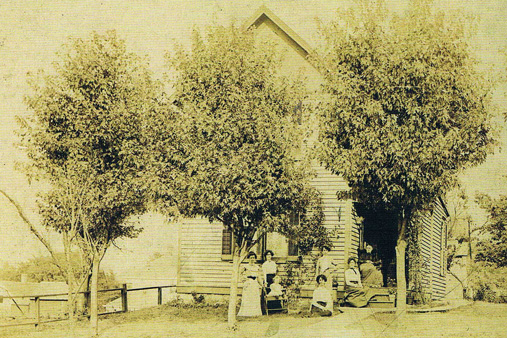
A new book celebrating the 100-year history of the Redemptorist Church at 3333 Broadway notes the church was once the “center of the Catholic universe in Midtown.” It chronicles the relationships between the church and the neighborhoods around it as Kansas City grew and changed. Among the milestones the book records:
- Redemptorist priests and brothers arrived in Kansas City in 1878. They built a small brick monastery on Old Westport Road. At that time, the monastery was outside the Kansas City limits and about a mile from the established town of Westport. The small church drew local Catholics from surrounding settlements, and the parish was recognized in 1882.
- An Irish “Kerry patch” develops west of Broadway. In 1910, the City Beautiful Movement swept Kansas City. It led to removing the old shanties in the Penn Valley Ravine, now Penn Valley Park. Broadway became a “premier neighborhood lined with three-story homes, brick apartment buildings, and new businesses.” Many Irish people moved into the area west of Broadway, which came to be known as the “Kerry patch.”
- The laying of the cornerstone for the current church at 3333 Broadway was one of the grandest celebrations Kansas City ever held. “There was a parade of Catholic societies before the ceremonies. The Irish, Germans, Italians, and Slovaks marched with bands and societies, followed by Catholic organizations. Afterwards there was a religious procession. A detail of mounted police headed the parade.” Much of the native limestone used to build the church was hauled from Pat Sullivan’s quarry, located in what is now Roanoke Park.
- Neighborhoods grew around the new church. New neighborhoods such as Coleman Highlands, Valentine, Roanoke, and Old Hyde Park developed, with a mix of professional and working-class families. By the 1930s, schoolchildren from the surrounding neighborhoods flocked to the church for daily mass. During the Depression, the church and the neighborhoods suffered, and many of the grand homes on Broadway were torn down or converted into businesses.
- During the 1940s, the church was the center of a “Catholic universe in Midtown.” The close-knit parish had an active social club, serving as a matchmaker for many young couples. The area around Redemptorist supported three funeral homes, the popular Jack Frost Donut Shop, Velvet Creme Popcorn, James Browne’s Grocery, and three drug stores. Residents danced at Drexel Hall on Linwood and swam and bowled at the PlaMor indoor entertainment complex at 32nd and Main. Two movie theaters, the Uptown and the Vogue, were popular.
- The opening of Southwest Trafficway in 1950 “established a physical barrier that cut through the parish.” This era began the rampant suburban growth of the 1960s and 1970s and demographic changes in the city.
The Book Redemptorist Church: Our Lady of Perpetual Help/Celebrating a Century 1912-2012 is available at the church and at Browne’s Deli, 3300 Pennsylvania. It was written by Pat O’Neil and Jim Cosgrove, with photography by David Shaughnessy and cover design by Dan Regan. It was even printed in Midtown by the Covington Group.